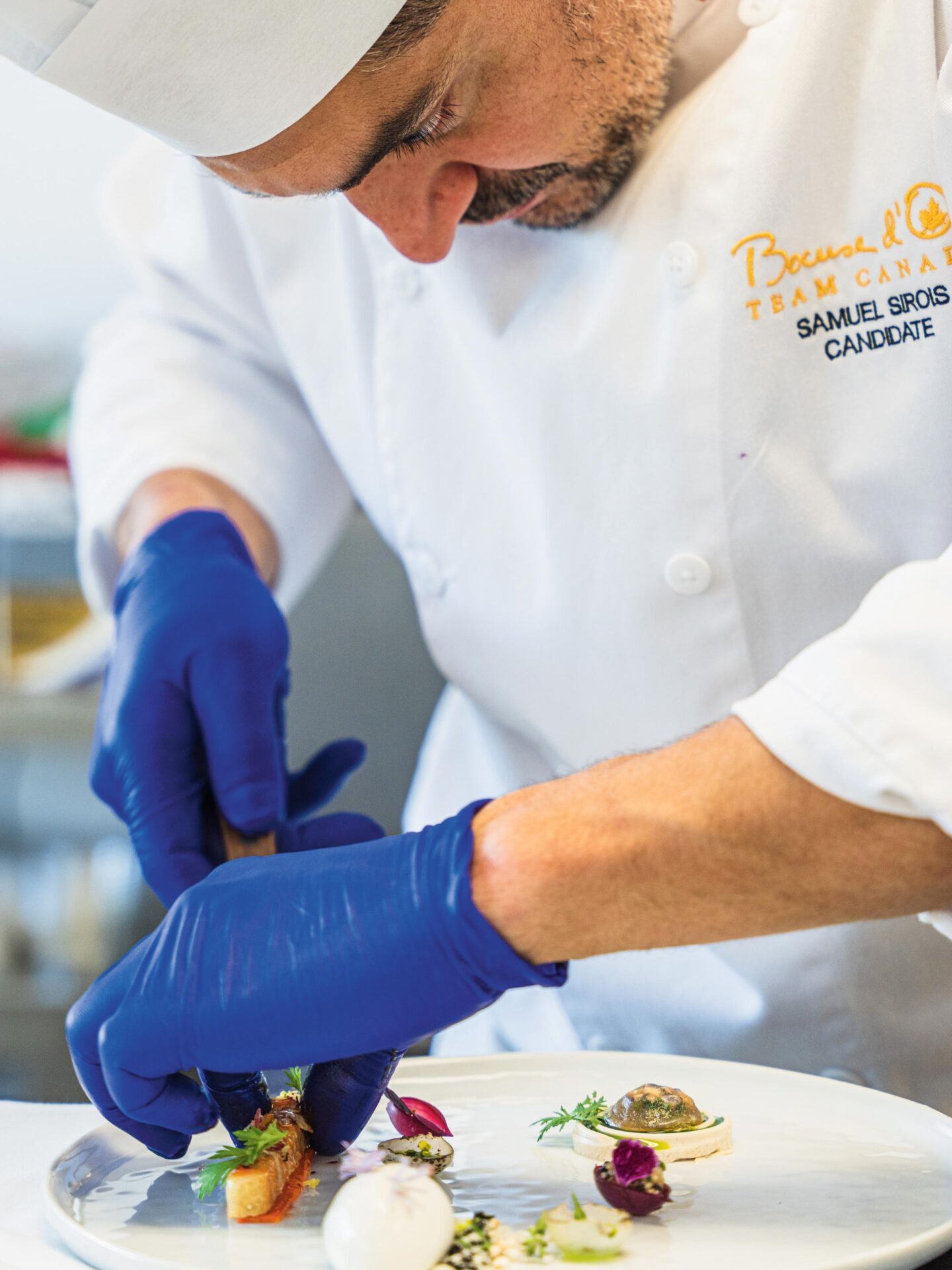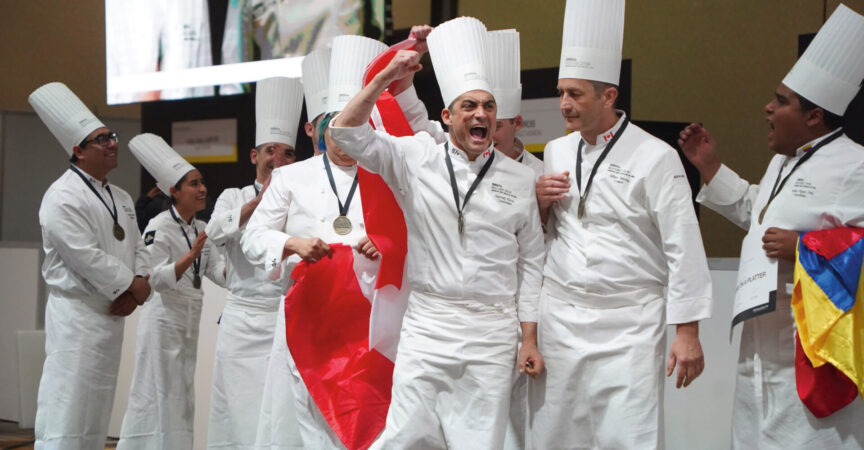Off to the Bocuse d’Or Finals
Team Canada won silver at the continental selection of the most prestigious culinary competition on Earth! Here’s why it should matter to the food service industry…

Specially designed by Montreal’s RICOSTUDIO, the platter is a tribute to the king of the Great North’s rivers: the salmon. Meant to celebrate Canada and tell a story of the landscapes of our Canadian winters, the various components included Canadian corn, mushrooms, fennel, asparagus and Canadian forest lichen to only name a few.
THEY DID IT! At the Bocuse d’Or in Santiago Chile, our national culinary team took second place and won their golden ticket to the world finals in Lyon, France this January. Though we can be proud of their stellar accomplishment, why should the Canadian foodservice industry care and get behind our national culinary team?
While the world’s greatest athletes will soon compete in the World Cup and the World Series, some of the planet’s greatest chefs are busy training for the Olympics of food: the Bocuse d’Or. In our summer issue, MENU highlighted the 35-year-old international competition known to be the most prestigious and most challenging on Earth. With more than 60 countries competing for one of the 24 spots to cook in France, the event makes fine dining an arena sport and comes with all the trimmings including uniforms, judges, cheering fans holding flags, bronze-silver-and-gold statuettes, and winners on podiums beaming while their national anthem blares in the speakers.
For the uninitiated, the Bocuse d’Or takes place every two years in France and features continental finalists battling to out-cook each other over the course of the two-day competition created by the world renowned chef, Paul Bocuse. And while there’s glory in winning one of the culinary Oscars, the road to Lyon is a long process that takes passion, dedication and a strong desire for perfection. “Our two-year process starts with a call for applicants,” explains Thomas Delannoy, President of Chefs Canada, the organization that manages the team. “Once the hopefuls have been interviewed by our board, four are selected to compete at the Restaurants Canada show in April. Based on their food mastery, technique and experience, the panel of chefs and industry professionals elect our national culinary athlete. Then we repeat a similar process to find the commis (the chef’s right-hand man or woman who needs to be less than 22 years old at the time of the competition in France). When chosen to represent Canada on the world stage, our national culinary athletes drop everything to train in our National Training Center in Montreal for the Bocuse d’Or full time. It’s an experience of a lifetime.”
Canada has participated in every Bocuse d’Or since its inception in 1987 — with first candidate being Jamie Kennedy — but has never made it to the podium or even finished better than in fourth position. But the question isn’t really whether we can win or not — we can; the question is why participate at all?
THE BOCUSE D’OR:
A TEAM SPORT THAT NEEDS YOU!
If you ask most of your customers, they probably wouldn’t know much about the Bocuse d’Or or any other high-level competitions for that matter. Most probably wouldn’t particularly care about fancy plates created with tweezers, molds, emulsions and eatable flowers even if shows like Top Chef, Iron Chef, Chopped and Hell’s Kitchen have taken over prime time TV. Though chefs like to say that they just want to make people happy with their food, the truth is, they are competitive, creative, driven and won’t shy away from the thrill of the fight to scoop a position on the “100 best” or Michelin’s best lists. And customers eat it all! While those rankings help diners with limited budgets spend their hard-earned dollars with minimum risk, the Bocuse d’Or winners’ circle plays at a much higher level, fostering national pride, and drawing the coveted eyes (and wallets) of global culinary tourists.
“Bocuse d’Or is about more than cooking. It’s about technical abilities and the creativity to produce showpieces within minimal time and under pressure but, most of all, it’s about planting the nation’s flag on European haute cuisine and beating the French at their own game, and that makes a career overnight,” shares Samuel Sirois, our national culinary athlete. “We’re not figure skaters or skiers at the Olympics, but Team Canada is working to represent the local restaurant industry and define, in the eyes of the world, what Canadian food is.”
Culinary tourism is big business. Prior to the pandemic, the World Travel and Tourism Council estimated the sector’s contribution to be 10.3 per cent of the world’s GDP (US $9.6 trillion), with international visitors spending upwards of US$1.8 trillion ($278.9 billion directly spent in foodservice in 2019). In 2021, following a loss of almost US$4.9 trillion, travel and tourism increased by 21.7 per cent, an increase of one trillion dollars USD.1
While cuisine has always been an important part of most travel experiences, the concept of traveling to a destination specifically for its food and beverage offering is a relatively recent trend. It is estimated that 80 per cent of travelers will research the culinary offering before they go on a trip while 70 per cent will pick a destination based on its food and beverage. And while 70 per cent of visitors state they bring local food back home as gifts, culinary tourism “products” including food events (79 per cent), gastronomic routes and cooking classes (62 per cent), and visits to markets and local producers (53 per cent) are top activities sought by travelers.

Countries like France that have taken home the gold at Bocuse d’Or multiple times are undeniably top destinations for gastrotourism. But in more recent years, following the wins by Scandinavian countries Norway, Denmark and Sweden, have seen a growing focus on their tourism. Or take Iceland, a small country that made it to the podium in 2017 that has since seen a 19 per cent annualized growth rate, far outpacing any of its peers. And that is why the U.S., Asia and Europe get funding to participate in culinary competitions, invest in their top culinary talents and as a result have consistently dominated the Bocuse d’Or over the years.
“Food tourism plays a significant role in preserving local heritage while driving innovation,” concludes Delannoy. “By increasing visitor demand for local fare, food tourism contributes to the long-term sustainability of local agriculture, foodservice businesses, communities and culture. That has been the foundation of Chefs Canada from the start as we aim to inspire the industry technically and creatively, to build on the promise of sharing our expertise with each other and the next generation. It’s about working together to promote our terroir and our producers, helping to give our profession the lustre it once had, but most importantly, to put Canada at the top of the list of culinary destinations for travelers – and THAT benefits every restaurant, hotel and foodservice business.” in the country!”
BECOME AN AMBASSAD’OR!
Prior to the Americas, Delannoy had promised to take the top prizes in an interview… and the team didn’t disappoint. Now we need more support from the provincial and federal government, sponsors, and foodies but most of all from you, chefs and food and beverage professionals from coast-to-coast. Join more than 350 Ambassad’Ors by uploading your photo on https://www.chefscanada.com/ambassador.html.









